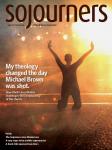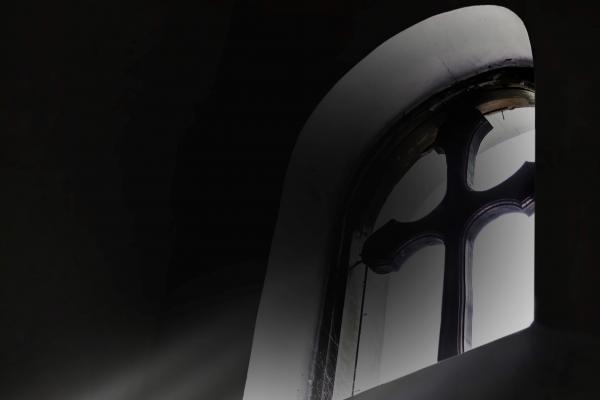AN IRAQ WAR VETERAN passes the offering plate after listening to a sermon on Christian persecution in the early church—tales of torture and execution. A 19-year-old student—home for the summer from college, where her first experience at a fraternity party turned violent—listens to her childhood pastor recite the story of David and Bathsheba and David’s subsequent path to redemption. A mother placates her two children with Cheerios and raisins as she struggles through the exhortations to spousal submission, hiding bruised arms under long sleeves in the middle of July.
The Christian story is littered with trauma—from slavery (the Israelites in Egypt) to sexual assault and abuse (Dinah, Tamar, Bathsheba) to the trauma of war (see: much of the Old Testament) to, of course, the crucifixion of Jesus and martyrdom of his disciples.
There is possibly no better resource for understanding the implications of and need for healing from trauma than faith communities pointing to the cross and Jesus’ answer to violence. Both the need and the opportunity are great. But perhaps too often Christians proclaim the message of Easter—victory and restoration—while skipping past the violence and trauma of Good Friday. Some theologies explain away that violence as a necessary component of ultimate salvation—but let’s get to the salvation part, okay?—leaving survivors of trauma who fill our Sunday pews without a touchstone for healing within the very communities that purport to be safe spaces.
“There’s this sense that, as Christians, we are familiar with death. ... We aren’t very good at lingering with people in the place where death and life intersect,” said Rachael Anne Clinton, a pastor, teacher, and trauma specialist at The Allender Center at The Seattle School of Theology and Psychology.
However, according to Clinton, there is a growing awareness of the interplay between those more troubling bits of biblical text and how churches and clergy are learning to serve the whole human person. The Allender Center focuses on trauma, which includes studying the brain and body holistically, and instructs counselors on how to effectively engage survivors’ stories of trauma in a way that honors the image of God in each person. Clinton said many students—both in their counseling and master of divinity programs—are coming to The Seattle School because they want to critically engage on issues of trauma and aren’t necessarily finding the tools within their own seminaries or faith institutions.
Bethany Bylsma is one of them. A master’s candidate studying counseling psychology, Bylsma says some of that breakdown happens because of a more general misunderstanding of trauma and mental health.
“The church needs to face mental health as an issue that can be addressed and isn’t a matter of not praying enough about it,” Bylsma said. “The reasons our minds work the way they do is because of the trauma they’ve experienced.”
The vocation of pastoral care
For Clinton, the root of that misunderstanding lies in how denominational institutions have been structured since the Enlightenment. “The primary vocation for the pastor became teaching. Doctrine became the driving force of what would hold Christianity together,” Clinton said. Thus, seminaries focused on building a huge base of knowledge so clergy could go forth and preach the truth. “There was this move away from pastoral care and from the primary vocation for the pastor being a shepherd.”
Clinton says the shift was amplified by theologies crafted within very particular contexts. “Theology doesn’t happen within a vacuum; it has its own biases.”
Understanding that most atonement metaphors come out of a penal context perhaps allows for a different interpretation of the violence of the cross—one that doesn’t elevate victimization as holy. For pastors who have not experienced domestic violence or abuse, recognizing that their own experience marks a certain kind of privilege is an important step in finding a language that encourages safe space.
According to Clinton, the disconnect between doctrine and teaching vs. pastoral care as vocation persists in part because of the stigma around psychology and a perception that responses to trauma are purely “emotional”—and are thus difficult to address in a consistent way. But advocates point to a steady stream of research that could begin to bridge the perception gap for some by concretely connecting body and mind and responses to trauma, particularly around traumatic brain injury. TBI is most commonly referenced in connection with head trauma experienced by war veterans and professional football players. But one advocate who works on concussion issues calculated that as many as 20 million women each year could have TBI caused by domestic violence.
A change in best practices
With more and more research that makes connections between trauma, mental health, and behavior, there is hope for a more common understanding in all communities—including those of faith. “It’s a less intimidating way to begin to understand the impact of trauma on the brain and therefore the body,” Clinton said.
Jen Luettel Schweer, licensed counselor and associate director of sexual assault response and prevention services at Georgetown University, said the law enforcement community is already implementing new practices in response to such research — including giving victims two sleep cycles before doing in-depth interviews because of how the brain processes trauma; understanding “Swiss cheese” memory, when there are gaps in the trauma narrative; and realizing that often survivors will remember details out of order.
Understanding the nuances of trauma could help pastors lean into the responsibility of fully caring for those experiencing it within their communities. But first they need to overcome a common fear of taking the first step—a fear of saying the wrong thing.
“It feels very scary to think about someone in your faith community who has experienced this or who has done this,” Schweer said. “And then we really don’t have any framework because it’s not something that’s integrated into schools or that’s a common conversation or common language.”
For Schweer, it begins with actively forming relationships between advocates and faith communities and “showing up in the same spaces together.” While data from a 2014 Sojourners survey of Protestant pastors show that only 43 percent of pastors are familiar with sexual and domestic violence resources in their communities, 81 percent said they would do more if they had training and resources. It starts with seeking out those resources with the knowledge that they will be necessary—in light of sobering statistics that 20 people per minute are the victims of physical violence by an intimate partner in the U.S., according to the Centers for Disease Control and Prevention. Those victims are friends and neighbors in our communities, our schools—our pews.
Faith groups are ‘absolutely critical’
Advocacy groups, first responders, public health programs, and many others invest in addressing the epidemic of gender-based and intimate partner violence. But, as made explicit by experts in the field at a roundtable discussion earlier this year at Georgetown’s Berkley Center for Religion, Peace, and World Affairs, the role of faith communities in addressing the issue is essential.
“The relationship between advocacy agencies and all of the folks supporting survivors in communities and the connection with religious and faith-based spaces is absolutely critical,” Laura Kovach, director of Georgetown’s Women’s Center, said at the gathering. “We cannot provide comprehensive care to survivors without our religious communities and institutions.”
Indeed, there have been some data that indicate the shared social interaction of religious communities can actually serve to mitigate the loss of trust experienced by survivors of sexual assault. A report this year on research conducted at Baylor University makes a lofty claim: that religion can help sexual assault survivors “cope and overcome the emotional damage.”
“It’s not just about [church] attendance, but about being embedded in a religious social network and about that being a part of your identity,” researcher Jeffrey Tamburello said in the report.
Schweer says that identity piece is essential for counseling survivors of trauma.
“One of the first things we do as counselors and advocates is we ask ‘what is your support system?’ ... For many of our students, a spiritual component is present with that,” Schweer said. “If we’re doing our jobs well and correctly as advocates and counselors who do interpersonal violence work, we are figuring out how to help them integrate that in a way that’s helpful to them.” For example, if going to Mass feels like a safe space for a particular survivor, Schweer says, a good advocate will ensure that attendance is part of a plan for coping with stress and healing.
Equipping ourselves to address trauma
But along with that essential role in the healing process comes the responsibility on the part of the pastor and faith community to address trauma and survivors of trauma with care and respect. Beyond providing references to advocates in times of crisis, faith leaders should be properly equipping themselves with the tools to address trauma theologically.
According to the Sojourners survey, two- thirds of pastors speak once or less per year about sexual or domestic violence. But there’s no shortage of material to do so appropriately and in an integrated way.
“Fortunately and unfortunately our text is full of stories that are very complex and sometimes hard to read and look at,” Clinton said. “For me as a pastor, that’s where I always encourage pastors to start.”
We Will Speak Out has a sermon guide, developed by health experts at IMA World Health and ordained ministers, that includes educational resources and sample sermons. Sojourners has published “I Believe You: Sexual Violence and the Church,” an e-book for small groups to engage and offer space for discussion and story sharing.
Clinton said that pastors should move beyond presenting those liturgical texts and discussion guides in a simply informational way. Create space for people to respond. Engage texts such as Lamentations and Psalms to allow for some reflection within that space.
When in doubt, seek additional education or training: Some seminaries and institutions such as The Seattle School offer lay certificates in counseling. Read about the intersection of theology and trauma, about the effects of trauma on the brain, and about how to use a better common language.
And finally, reinforce the notion that the church community is in fact a safe space—for discussion, for reporting, for healing. Critiques abound of both faith communities and college campuses—once considered havens where survivors could thrive and feel safe—in how they address or don’t address trauma, particularly sexual assault and abuse. And while very often these are valid sources of accountability, the sudden upswing in attention has the potential for negative effects.
“I want survivors in all of this [to know] that there are people who support them,” Schweer said. “I also want survivors to know that if this happens to them, it’s not a hopeless situation, and there are services like ours and there are people in the community, and this is not a journey they have to take alone.”
If there is ever a place for survivors of violence to know they are not on their journey alone, it should be within communities of faith, embraced by the love of a God who has walked it before.

Got something to say about what you're reading? We value your feedback!

